Waxy Monkey Tree frogs, also known as Giant leaf frogs, bicolor tree frogs, and giant monkey frogs are a species of leaf frogs that are native to South America and are known for maintaining their body temperature very high which other frog species can’t tolerate. The arboreal frog species is set “to live a double life” because its tadpole stage survives in water and adulthood survives on the land (especially in the trees). But are Waxy Monkey Tree frogs or Giant Leaf frogs good pets? Or should you avoid it as a beginner? Let’s find out.
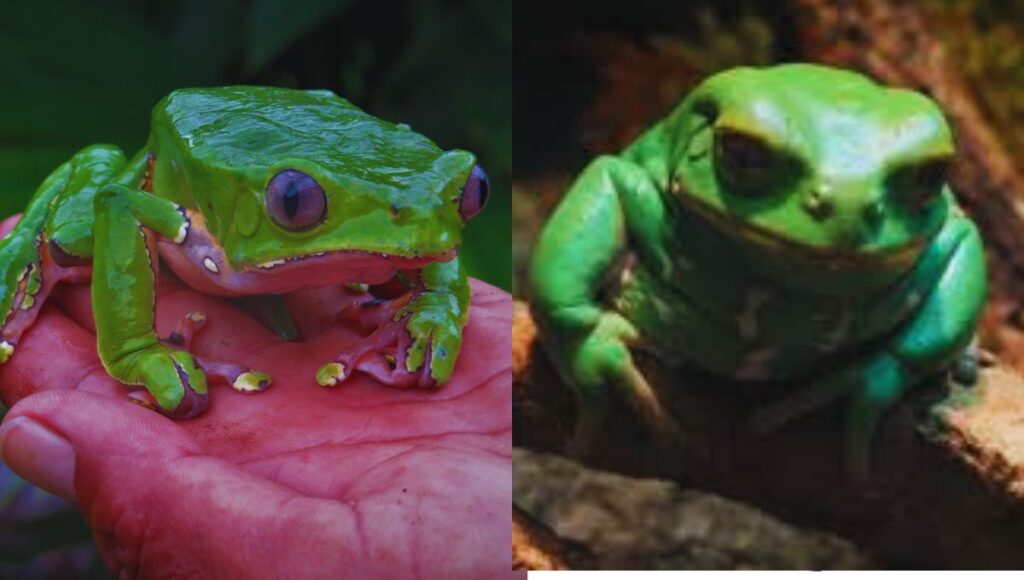
Table of Contents
Everything About Giant Monkey frogs:
In a Glimpse:
| Common Name | Waxy Monkey Tree Frog |
| Scientific Name | Phyllomedusa bicolor |
| Other Names | Giant leaf frog, bicolour tree frog, giant monkey frog |
| Maximum Length | 3.6-4.7 inches |
| Maximum Weight | 25-50 grams |
| Ranges | South America |
| Habitat | Warm and Moist, also dry Environment |
| Diet | Carnivore |
| IUCN Status | Least Concern |
| Lifespan | 5-7 years |
Geographical Distribution:
Giant Monkey frogs are native to South America. They are primarily found in the Amazon Basins of Brazil, Colombia, Bolivia, and Peru. The leaf frogs are also found in Venezuela (Guianan Region), the Guianas, and in the Cerrado of the state of Maranhão in Brazil.
Habitat:
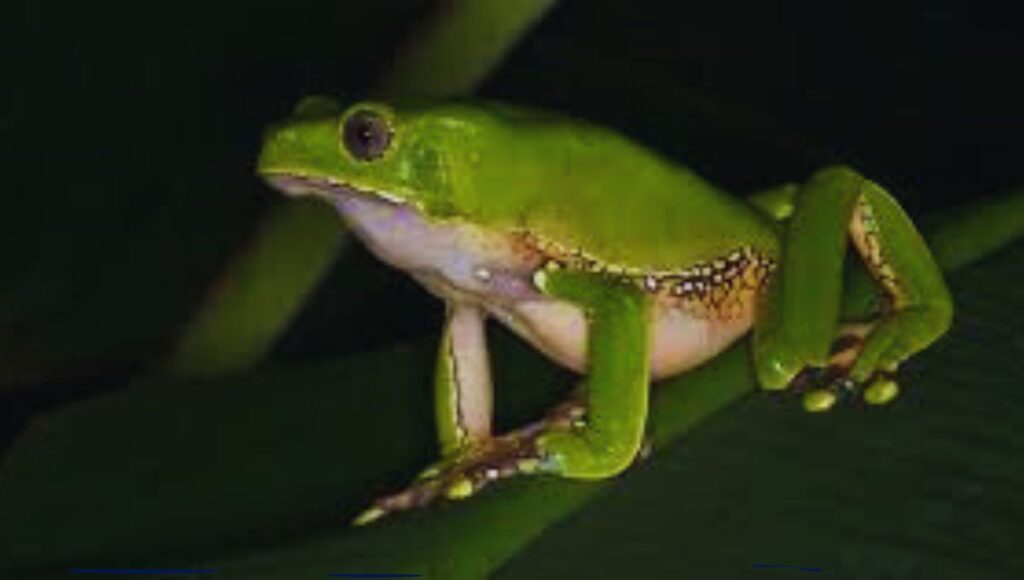
Giant leaf frogs are found in Amazon rainforests, especially in the gallery forests (forests formed as a corridor along rivers or wetlands). The frogs prefer moist and semi-moist environments and are also able to adapt to drier environments. They are also found at high elevations up to 1500m above sea level.
However, the frogs can cope with dry environments (Such as living in the dry Chaco Forests); they need water bodies nearby to reproduce and breed. Thus, the arboreal frogs inhibit the riparian zones of temporary and permanent ponds, streams, and humid montane forests. The Waxy Monkey Tree frogs love to sunbathe in an open, sunlit canopy rather than a sun-blocking canopy or a darker forest.
Physical Description: How do you identify a Waxy Monkey Tree frog?
Sexual dimorphism is present in the Giant leaf frogs as the females are larger than the males. The snout-vent length of females is 4.4–4.7 in (11-12 cm) and the males are 3.6–4.1 in (9.1-10.5 cm) in length. The average weight of these frogs is 25-50 grams.
The dorsum is lime-green with a white to yellow-white or cream-coloured belly. The lower lips, chest, and front legs have scattered white spots with dark frames that are denser in the flanks and hind legs. The females have round snouts whereas the males can be characterized by loose skins on their throats which are Vocal sacs.
The fingers of the Waxy Monkey Tree frogs are transparent brown and have large, green adhesive discs, which is a distinctive feature of the species. A prominent gland extending from behind each eye over the tympanum (eardrums). The iris is dark grey and their large, bulging eyes with a vertical pupil come round at night to let more light in.
Why do Giant Leaf frogs known as Waxy Monkey Tree frogs?
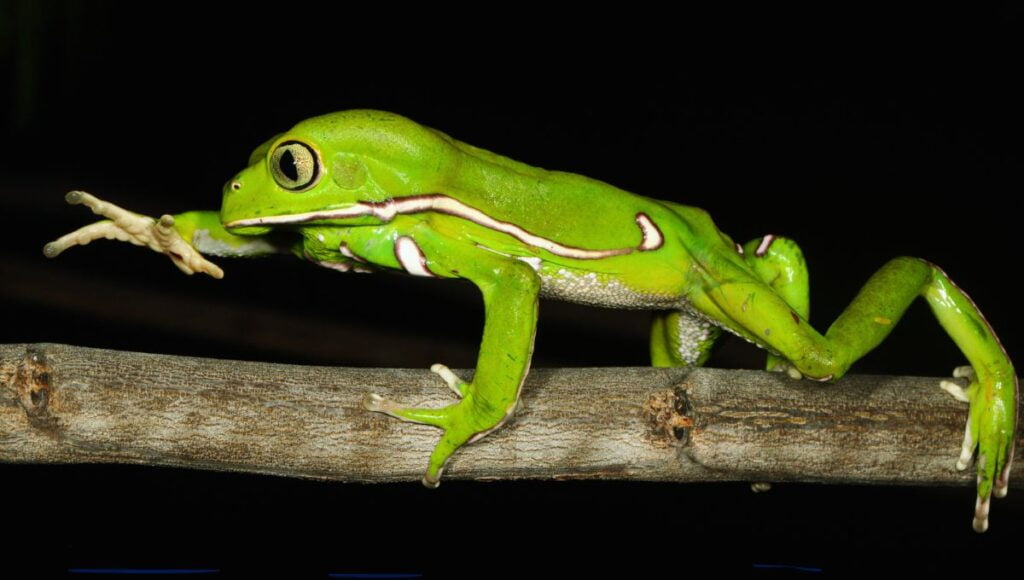
Giant Leaf frogs have waxy shiny skin (to prevent evaporation during dry seasons) that looks green in the day and bronze-green at night. The frogs are arboreal and nocturnal and known for their unique sitting postures that are similar to a monkey. When the frogs sit, their arms and legs extended, almost as if it’s propping themselves up. They are probably the only frog species with opposable thumbs, which allows them to get a firm grip on the thin branches like a monkey while walking through the trees.
This distinctive sitting posture is an adaptation to its environment as it reduces surface contact and wicks of moisture from the skin. Hence, the leaf frogs are also known as Waxy Monkey Tree frogs.
Defence Mechanism: Are Waxy Monkey Tree frogs poisonous?
To protect themselves against predators, Waxy Monkey Tree frogs secrete peptides in their skins that help them to defend against predators. The compounds of this peptide juice are still not confirmed. However, the juice is often used in the pharma industry for preparing medicines but its sister species (which almost looks similar) produces toxic substances in their skin. If your wounded or injured skin comes closer to that juice it might cause hepatitis, multiple organ failures, and other serious health problems.
Behaviour and Characteristics of Giant Monkey Frogs:
Giant monkey frogs are docile, nocturnal, and arboreal frog species. The leaf frogs can tolerate a wide range of temperatures (20-40 degrees Celsius). The upper limit of their body temperature is about 40 °C, which is much higher than other frogs or amphibian species can tolerate. This benefits the frogs usually do not need to expend water for thermoregulation unless the surrounding’s temperature crosses the limit. However, the Waxy Monkey Tree frogs can tolerate as low as 20 °C, but they mostly prefer 22-26 °C temperature.
Hunting Behaviour:
The Giant leaf frogs usually sit still and wait for prey. Once the prey arrives within their reach, the frogs catch it with their fingers (especially with their opposable thumbs that help to grip firmly).
Reproductive Behaviour:
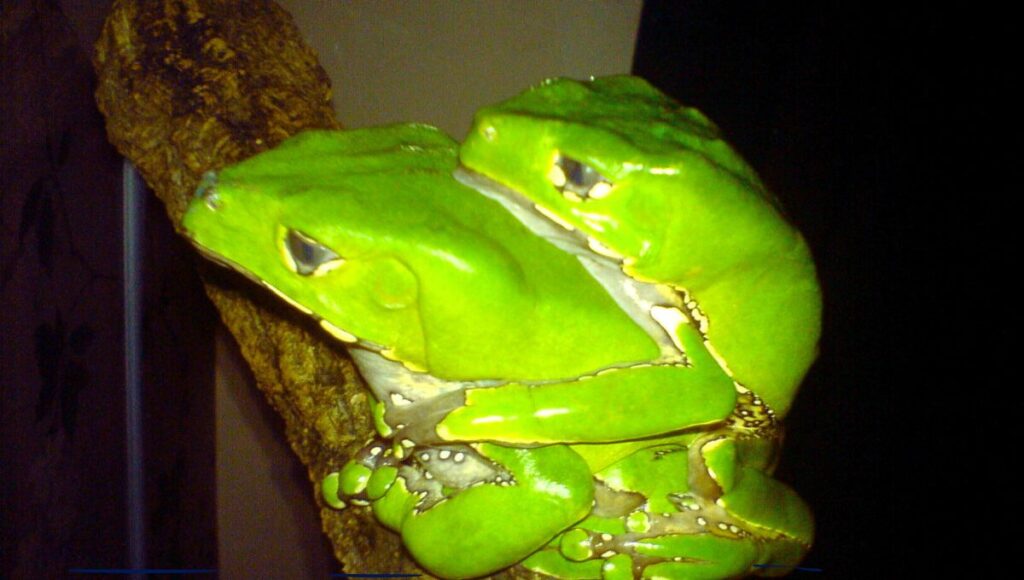
Like other amphibians, while mating the Giant monkey frogs attempt an intimate embrace, amplexus. During the mating season (especially the rainy season, October-March) the males develop brown nuptial pads which improve the male’s grip on the female during amplexus. The glands below the surface of the nuptial pads also secrete pheromones (amplexins) to improve the courtship duration.
The male and female Waxy Monkey Tree frogs construct a leaf nest above forest pools (approximately 70 cm above water) and lay their eggs (600-800 eggs) there. After two weeks, the eggs are hatched and the tadpoles directly fall into the water where they develop as adults.
Hibernation:
When the temperature of the environment is more than their body temperature (usually above 40 °C), the Giant Leaf frogs during the day enter torpor (a state of physical or mental inactivity) for short periods to regulate body temperature in hot environments. Their waxy skin layer controls the amount of evaporation through their skin and maintains the body temperature.
Are the Waxy Monkey Tree frogs aggressive?
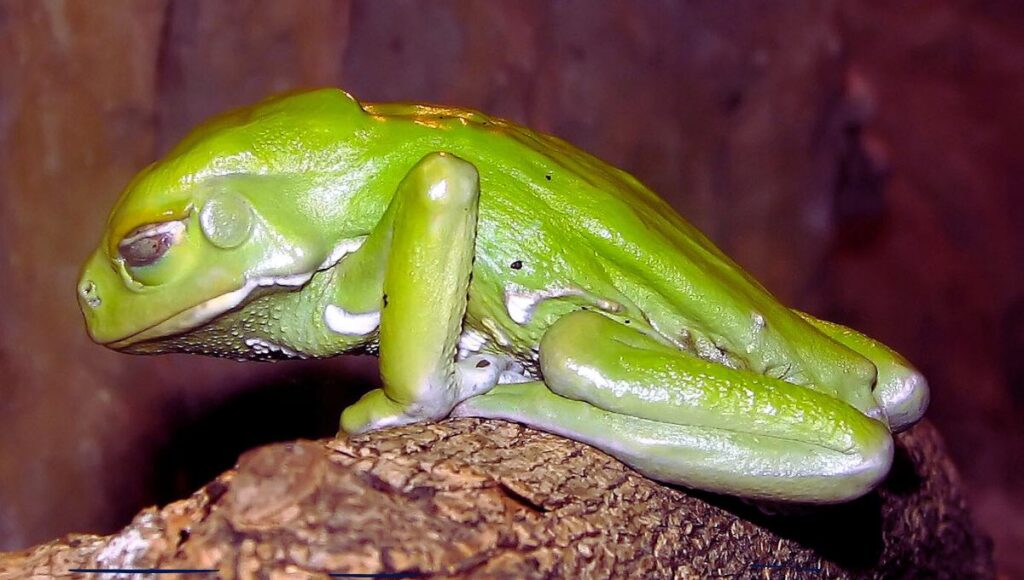
Waxy Monkey Tree frogs are docile by nature and are not aggressive towards humans; even they often try to avoid human interaction. But during mating seasons, the males fight each other for mating rights by using their heads to separate another male who is attached to a female. The male Giant monkey frogs also warn the rival frogs using aggressive calls and their hind legs to kick their rivals.
Vocalization:
The Giant Leaf frogs use “Crawk Crawk Crawk” mating calls during the mating season from trees in tropical humid forests to attract the females. However, during the fight with other males in the breeding season, the males become more vocal and can be heard by predators from a long distance, which allows the predators to hunt them easily. You can hear their sound all night from October to March.
Physical Activities:
Due to their human-like hand and opposable thumbs, the Waxy Monkey Tree frogs are very poor at jumping or hopping. As the opposable thumbs allow them to grab the tree branches firmly, they can easily climb and walk on the trees rather than jumping. The tadpoles of the frogs become adults in the water and hence they are good at swimming as well.
Diets:
The Giant Waxy Monkey Tree frogs are completely carnivorous by nature. As they are nocturnal, the leaf frogs start hunting after sunset. They sit still and wait for the prey patiently and once they find the prey in their reach they grab them with their strong hands and eat them. Small insects like crickets, mosquitoes, cockroaches, locusts, roaches, mealworms, superworms, waxworms, and other invertebrates are their favourite foods.
Predators and Threats:
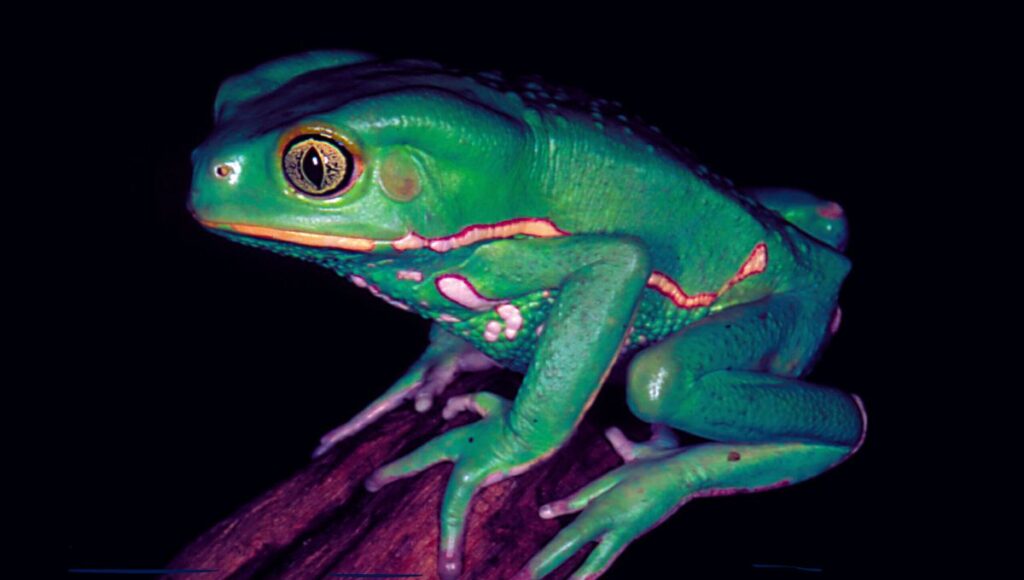
During the breeding season, when the male waxy frogs fight each other, they create lots of sound and it attracts more predators to hunt them. Snakes, monkeys, Bullfrogs, and prey birds are their main predators.
However, the predation rates of Giant Leaf frogs’ eggs are very high (almost 61%) because these eggs are excellent sources of proteins for the predators. Phorid flies, staphylinid beetles, Rove beetles, prey birds, snakes, and mammals, especially capuchin monkeys consume their eggs for nutrition.
However, the Giant Monkey frogs also face many anthropogenic threats such as habitat loss due to the destruction of Amazon rainforests, expansion of agriculture and human settlements, pollution such as usage of pesticides and other chemicals, and destruction of the waterbodies in the areas that hurt the population of the leaf frogs. Additionally, due to their importance in the medicine industry, the Waxy Monkey Tree frogs are also prone to illegal trafficking and poaching which is a threat to the frog species.
Conservation Status:
Green Leaf frogs are listed as “Least Concern” in the IUCN Red List of Threatened Species as their population is considered stable in the wild.
Disease and Health Issues:
The Green Monkey frogs are very susceptible to Batrachochytrium dendrobatidis (Bd), a type of Chytrid fungus which already led to the extinction of many frogs and toad species such as Mountain Chicken frogs. Apart from that the frogs are also vulnerable to surface water contaminants, and endocrine disruptors that affect reproduction and thyroid hormone levels. Endocrine disruptors are found in waters contaminated by pesticides, cleaning agents, and other medications.
Lifespan:
The Waxy Monkey Tree frogs live 5-7 years in the wild but with proper care, they can live 10-12 years in captivity.
Ecological and Medicinal Value:
As Giant leaf frogs are insectivorous, they can be used in pest control. However, the frogs also have medicinal value. The skin secretion of the frogs is known as Vacina do sapo (frog vaccine), which contains compounds like opioid peptides deltorphin, deltorphin I, deltorphin II and dermorphin. The medicinal value of Waxy Monkey Tree frogs has seen increasing popularity in cleansing rituals, such as it prevents intense vomiting.
Are Waxy Monkey Tree frogs or Giant Leaf frogs good pets?
There is no actual answer for this because it completely depends on the experience of the owner. As Waxy Monkey Tree frogs are native to Amazon basin rainforests, it is difficult to replicate such an environment at home sometimes, especially for beginners. If you can create such an environment at your home, Giant Leaf frogs can be an amazing and exotic pet for you.
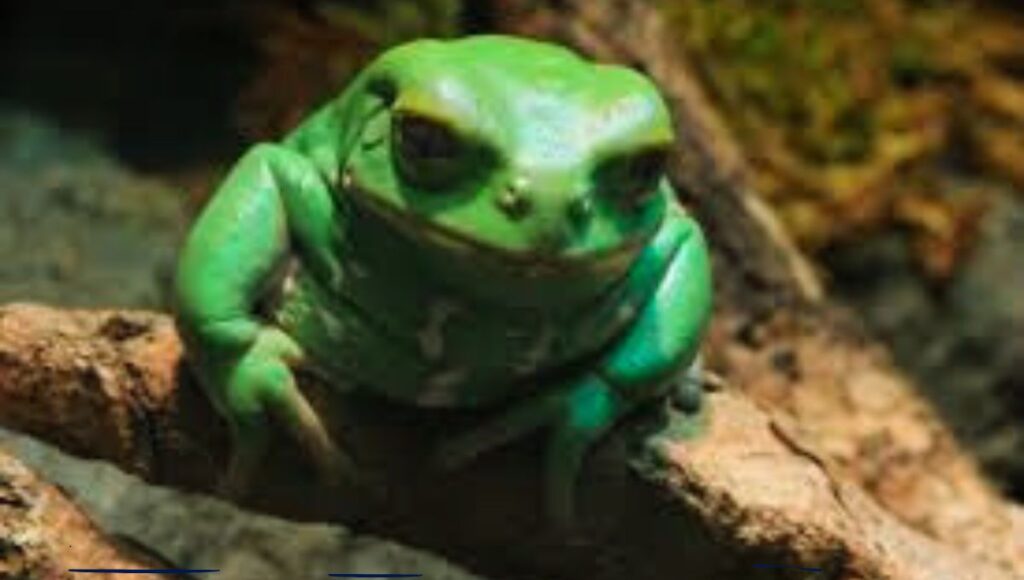
Giant Monkey frogs are usually docile, friendly, calm, and less active amphibians. They are not aggressive or harmful to humans. They are nocturnal, hence in the daytime, they rest on the branches of the trees sitting like monkeys which is very entertaining to watch. After the sunset, the frogs become more active and hunt their prey using their human-like hand which is also delightful to watch.
The best part of these frogs is that, the Waxy Monkey leaf frogs are easy to care for, and low-maintenance frogs. Unlike other frogs, you can keep them in groups in the same container which is another advantage.
Apart from that, you can also enjoy their fight during the breeding season, as the males often fight another male using their head and sometimes kick using their hind legs. The Giant Monkey frogs can tolerate human handling to some extent which means you can play with them if you want to.
How do you buy a Waxy Monkey Tree frog?
It is advisable to avoid buying these frogs from illegal pet markets because parasites or fungi often attack those frogs. You can buy the frogs from reputed breeders or pet shops that ensure the Waxy Monkey Tree frogs are born and bred in captivity. Before buying the frogs ensure they are healthy and ask for their proof of origin and health certificate from the breeder or pet shop owners. You must also check the laws of your country or state to know if the frog is banned to keep as a pet in your locality (which is probably not suitable for Giant Leaf frogs as these frogs are one of the innocent frogs to keep as pets).
You can also check out online platforms to purchase the frogs but before purchasing check the reviews, policies, and other important information about the frogs and website. The price of a Waxy Monkey Tree frog completely depends on their age, sex, size, and location. You can expect to spend at least $50 to buy a Giant leaf frog who bred in captivity.
Requirements and Care:
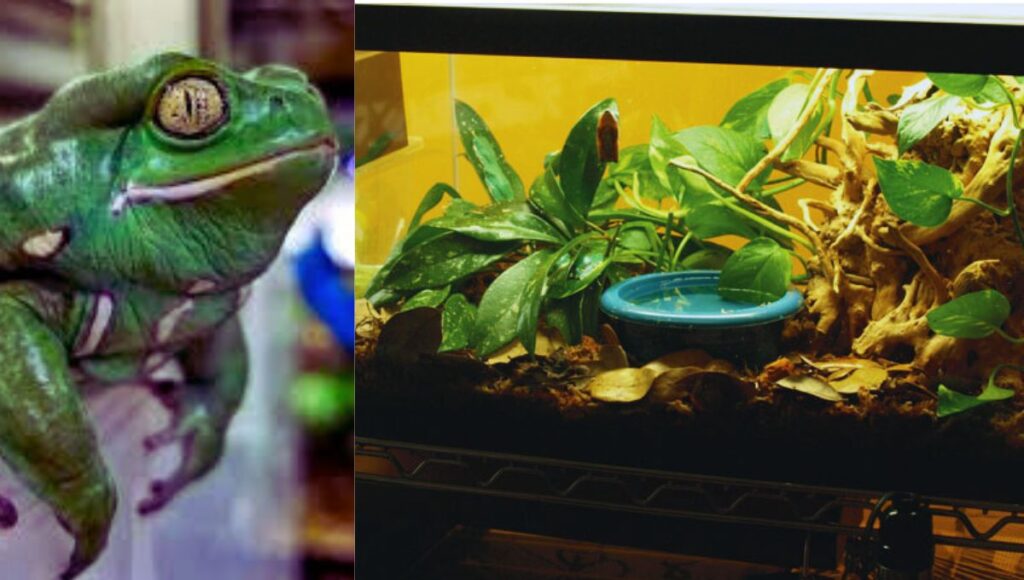
Enclosure:
Waxy Monkey tree frogs are medium-sized arboreal frogs who mostly prefer to spend time on trees. Hence, you need a bigger tank to accommodate them. The bigger the tank, the better for the frogs but if you lack space, you can have a minimum of 25 gallons of tanks per couple. The enclosure must have a secure lid with proper ventilation, otherwise the leaf frogs might escape.
The terrarium also includes some live or artificial plants that provide places to hide for the frogs. Try to decorate the tank with live tropical trees because it is native to the frog species. Hence, the enclosure should be high enough (at least 25-30 inches high) and you can also add some dead branches to the top of the terrarium to enrich the environment.
The aquatic part is also necessary to collect the tadpoles during their breeding season. Sometimes adult frogs also take a bath in that water from time to time. Filtration is not necessary if you change the water from time to time. However, the aquatic parts must not exceed 25-30% of the enclosure.
Can you keep two or more Waxy Monkey Tree frogs in the same tank?
Yes, you can keep 2-8 Waxy Monkey Tree frogs in the same container depending on the tank’s size. The frogs are social and can live in groups. However, remember these Giant Tree frogs may show cannibalistic nature and can consume their own species. Hence, it is advised to keep only the frogs of similar size in the same container.
Can you keep a Waxy Monkey Tree frog with other frogs or amphibian species?
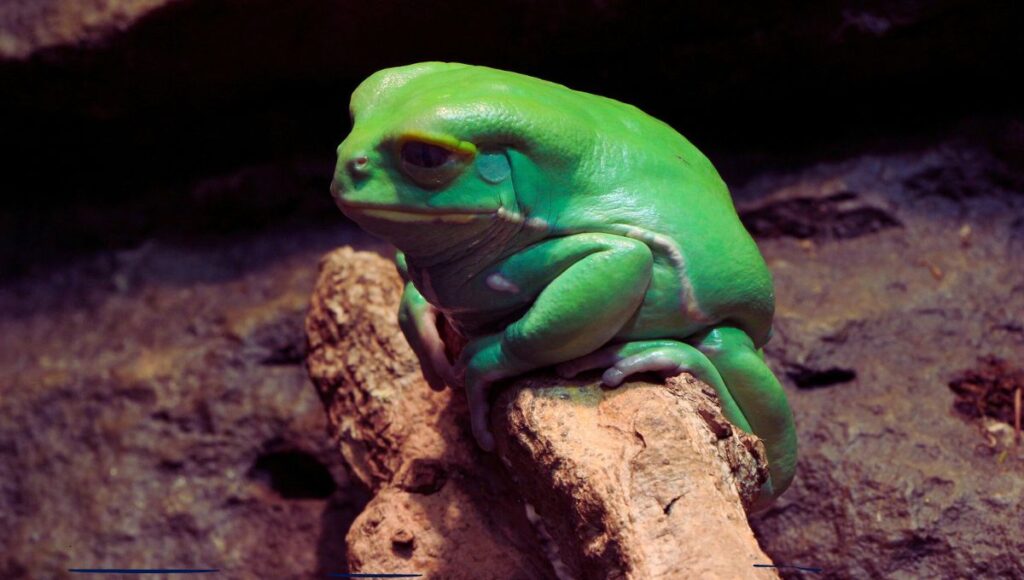
It is recommended not to keep a Waxy Monkey Tree frog with other frog or amphibian species. Because most of the frogs or amphibians show aggressive or cannibalistic natures. Hence, the stronger frog will kill and consume the weaker frog. Apart from that, most of the frog species also secrete toxic substances from their skins as a part of a defence mechanism that may harm or kill the other frog species. Hence, try to avoid keeping two different types of frog species in the same container.
Substrate:
You can use artificial or natural substrates for the territorial part of the container. If you use green plastic carpet (which is easy to find in the pet shops), it can be washed and disinfected regularly. Apart from this, you can also use a kitchen towel that is changed periodically or use pine bark as an artificial substrate.
If you want to plant live plants such as ferns or ivies inside the tank, you can use Moist sphagnum moss, such as the Zilla Fir & Sphagnum Peat Moss Mix as substrate. To prevent the ground from being soaked, always drain at the bottom of the land part below the ground.
Temperature and Humidity:
Waxy Monkey Tree frogs require a warm but dry environment to thrive. You must keep the temperature of the enclosure between 75 and 85 degrees Fahrenheit and use a thermometer to monitor the temperature. In case, the enclosure is cold, use a heat lamp or heat mat to increase the temperature but avoid overheating it.
The Giant Monkey frogs need very low humidity of 40-60%. Thus it is very important to have excellent ventilation in the enclosure, otherwise, the aquatic part may moisten the environment.
Lighting:
A 12-hour day-night circle is necessary to regulate their daily activities. You can use conventional daylight neon tubes or low-wattage UVA/UVB lights to provide them with the necessary vitamin D.
Food and Water:
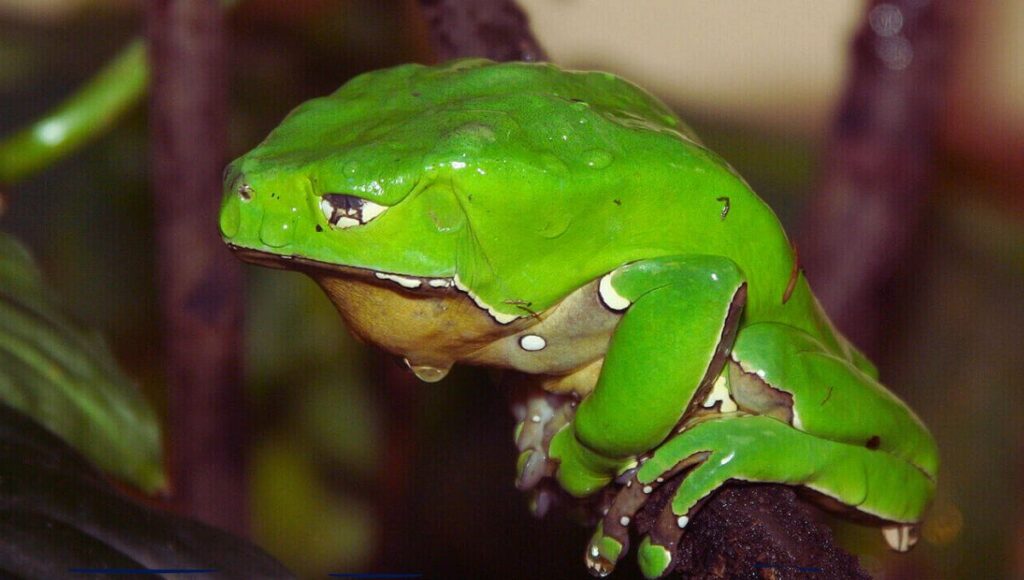
The amount of food a Waxy Monkey Tree frogs consume depends on its age, sex, health condition, and appetite level. As the frogs are completely carnivorous, you can feed them with insects such as flies, mealworms, crickets, spiders, butterflies, grasshoppers, earthworms, and superworms. Once or twice a week dust their food with calcium and vitamin supplements. Don’t feed them chitinous invertebrates as the chitin, the shell of the insects, is not very well digested.
You need to provide them with clean dechlorinated water free from contaminations. You need to feed the tadpoles daily but once they become adult, feed them every other day to prevent obesity.
Handling:
Unlike other frogs, Waxy Monkey Tree frogs prefer human handling to some extent. You need to be careful while touching them. Excessive handling of the frogs will cause stress to them. Wear gloves before touching the frogs and wash your hands afterwards.
Cleaning:
You should clean the water dish, waste food, and dead insects from the enclosure regularly to prevent bacterial growth. Once a month, deep clean the tank with a mild disinfectant and rinse thoroughly with dechlorinated water. If the substrate doesn’t smell bad, change it every 12-16 weeks.
Health Issues to Notice:
As the Giant Monkey frogs live under UV lamps in captive care, they tend to develop stones in the bladder, which is unknown in the wild. Also to prevent dehydration, the frogs concentrate their urine, which eventually saturates its urinary tract.
To counter these health problems, you need to give your frog nutritious and varied diets. Research has shown that excessive eating of crickets develops stones in their bladder. Hence, you need to feed them only when they are hungry. You need to vary their food and also don’t give any food that is high in protein. Also, keep the frogs hydrated without increasing the humidity of the enclosure. These tips will help you to keep your Waxy Monkey Tree frogs healthy.
11 Interesting Facts About Waxy Monkey Tree Frogs (Giant Leaf Frogs):
- The frogs are native to South America and you can find them on the branches of the trees as they are arboreal.
- It is said that the frogs have two lives as their tadpoles survive in the water and after being adult they spend their time on trees.
- The females are bigger than the males, and Waxy Monkey Tree frogs are the only frog species with opposable thumbs that allow them to grip the branches of the trees firmly.
- Giant Leaf frogs have waxy shiny skins to prevent evaporation during the dry season and they can sit like monkeys in the branches of the trees.
- Waxy Monkey Tree frogs can tolerate up to 40 °C, which is not possible to tolerate for most of the frog species.
- Unlike other frog species that hunt by their long tongues, the Giant Monkey frogs hunt their prey using their hand and opposable thumbs.
- The male Waxy Monkey Tree frogs fight with each other for mating rights during breeding season and they use their hind legs to kick each other.
- Giant Leaf frogs create a nest and lay their eggs approximately 70 cm above water. After hatching, the tadpoles directly fall into the water.
- The eggs of Waxy Monkey Tree frogs are rich in protein and hence many predators hunt their eggs for nutritional values.
- The frogs secrete peptides in their skin which are used in the pharma industry but if the secretion comes close to the injured skin of humans, it can cause hepatitis, multi-organ failure, and another serious disease as well.
- The Green Leaf frogs may show cannibalism, still, you can put 2-8 similar sizes of giant leaf frogs in the same container depending on the container’s size.
Reference: Wikipedia
Also Read:
Pacman Frogs: Can You Keep Argentine Horned Frogs as Pets?
Are Glass Frogs Suitable Pets for Beginners? Everything You Should Know Before Buying